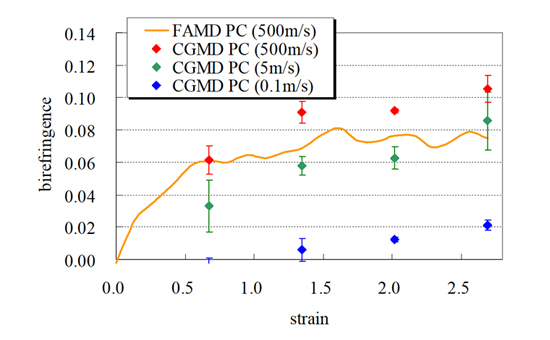- FAMD / CGMD
- Optical / Electrical / Magnetic
- Materials Science
[Analysis Example] Analysis of birefringence using coarse-grained molecular dynamics
Coarse-grained molecular dynamics and reverse mapping to evaluate birefringence
It is known that large deformations in polymeric materials can lead to oriented birefringence, and previous examples of J-OCTA have introduced full-atomistic molecular dynamics (FAMD) [1] and multi-scale approaches [2].
When using full-atomistic MD, the issue is that the time scale is short. This leads to high deformation rates and polymer relaxation in response to deformation does not complete in time, resulting in an over-orientated state. On the other hand, coarse-grained molecular dynamics (CGMD) can be applied to long time scales, i.e. deformation slower than full-atomistic MD.
Here, a coarse-grained model of polycarbonate (PC) was constructed using the coarse-grained potential estimation functionality included in J-OCTA. A uniaxial elongation calculation is performed using the coarse-grained MD and reverse-mapped to an full-atomistic model (Fig. 1).
After relaxation, birefringence was evaluated using the scenario function of J-OCTA as in [1].Fig. 2 shows how the birefringence changes with elongational deformation: compared to FAMD, CGMD can handle slower deformation velocities; when the velocity is reduced to 0.1 m/s, values close to the experimental values in the literature [3] are obtained.
 Fig.1. (top) Snapshot of uniaxial elongation calculation using coarse-grained MD
Fig.1. (top) Snapshot of uniaxial elongation calculation using coarse-grained MD
(bottom) Structure reverse-mapped from coarse-grained MD results to full-atomistic MD
 Fig.2. Change in birefringence with uniaxial elongation,
Fig.2. Change in birefringence with uniaxial elongation,
Results of different deformation rates for full-atomistic MD and coarse-grained MD
- References
- [1] https://www.j-octa.com/cases/caseA06/
- [2] (In Japanese) https://www.jsol-cae.com/product/material/jocta/cases/caseA37/
- [3] (In Japanese) J. Polymer Sci. and Tec., 51, pp237-243, (1994)


